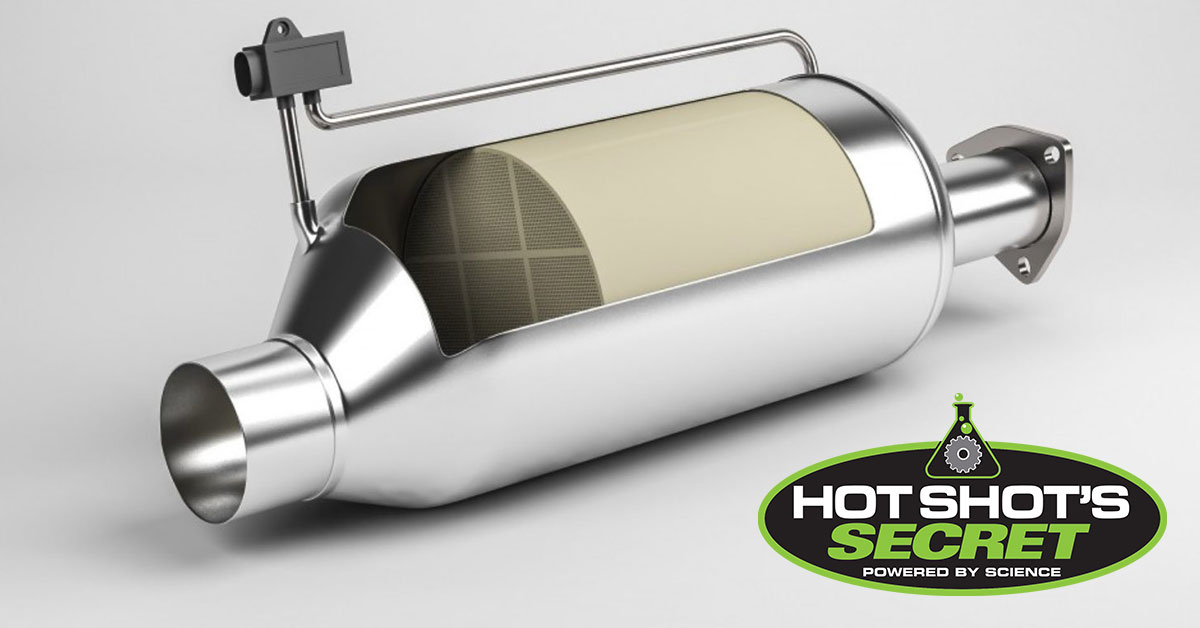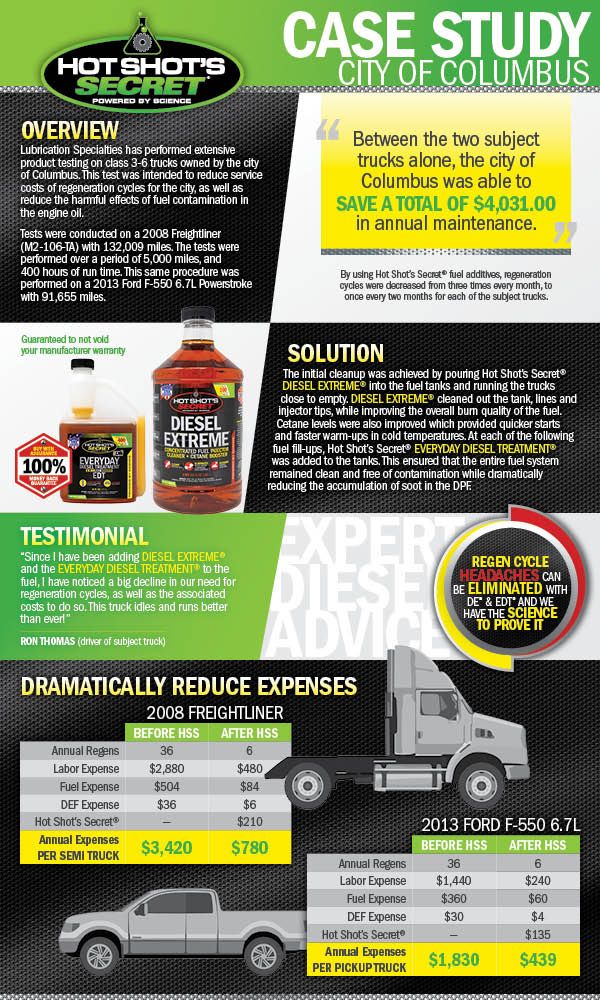
If you drive a truck made anytime over the last decade (2007 and later) you have a Diesel Particulate Filter (DPF) system on your truck to meet emissions standards. The system catches the remaining particles after the combustion cycle of your engine, similar to a catalytic converter on gas engines.
Most of the time you do not even know the system is working. Over time, the filter of the system needs to be cleaned from the un-burnt components of diesel fuel, carbon and particulates that accumulate into visible smoke from the exhaust. Cleaning happens via four methods — passive, active, parked and forced regeneration cycles.
What if you could cut down on the amount of regeneration cleaning cycles (regens)? You can — by up to 50% — by using Hot Shot’s Secret Diesel Extreme and Everyday Diesel Treatment.
We know regens happen because of soot build-up in the diesel particulate filter. So, if we can lower our soot output, we can lower our regens significantly. The best way to accomplish this is by achieving a more efficient burn of our diesel fuel.
There are two things needed to make this happen:
1. Having clean fuel injectors
2. Burning higher cetane rated fuel
If we keep our fuel injectors clean, this process allows the spray pattern to become a finer, more even mist that results in better burning of the fuel. This means less soot being pushed through our DPFs and fewer regens.
What Is a DPF?
A DPF is an exhaust treatment device that uses a honeycomblike structure made of ceramic to catch ash, soot or any other type of particulate matter so it can’t be ejected into the environment. In 2007, the Environmental Protection Agency (EPA) established emissions standards mandating that engine manufacturers use DPFs to trap particulate matter and control emissions.
What Is DPF Regeneration?
The DPF eliminates buildup by trapping and stowing exhaust, then periodically burning it to regenerate the filter. Regeneration prevents a buildup of excess soot in the filter as well as black smoke and harmful exhaust emissions. The DPF needs an extremely high temperature to burn off the soot particles, so the vehicle accomplishes this through several types of regeneration processes.
Passive Regeneration vs. Active Regeneration vs. Forced Regeneration
Passive, active and forced regeneration methods clean the DPF filter in different ways to support proper function:
- Passive regeneration: When you drive for an extended period of time, your vehicle’s exhaust reaches extremely high temperatures. For example, driving above 70 miles per hour for an extended period would be enough to burn the soot particles trapped in your DPF. However, most drivers typically don’t spend enough time at this rate of speed to depend on the passive regeneration process.
- Active regeneration: Manufacturers created an alternative to passive regeneration. Active regeneration begins when soot trapped in the DPF reaches a level around 45% of your DPF’s capacity. At this point, the DPF triggers postcombustion fuel injection to increase the temperature in the exhaust and burn away the soot.
- Forced regeneration: Forced regeneration occurs when a scan diagnostic tool begins the regeneration process due to an unusual circumstance. For example, the soot load in a DPF could have reached a critical point beyond what a normal passive or active regeneration process can handle.
Reducing Regens With Our Products
You can reduce the number of regeneration cycles you need with product solutions from Hot Shot’s Secret. Third-party testing from the City of Columbus has shown that Diesel Extreme and Everyday Diesel Treatment can slash regen needs by 50%!
Regens occur when soot builds up in the DPF over time. The most effective method to reduce these cycles is a more efficient burn of your diesel fuel. You can accomplish this goal with a clean fuel injector and by burning higher cetane-rated fuel. When you complete these steps, you can get far closer to the optimal balance of fuel and oxygen in the combustion chamber. Combining the ideal air-fuel ratio with high-quality fuel will achieve a more powerful burn and prevent large amounts of soot from passing through the DPF.
How Much Does It Cost for a New Filter?
It’s vital to clean your filter regularly to extend its useful life and maintain compliance with the regulations set by the EPA. On average, it costs around $2,000-$10,000 to replace the DPF in your truck. That’s why it’s critical to choose lubricants that can support proper maintenance and lengthen the time between necessary replacements.
Regeneration Cleaning Cycle Types
Passive regeneration occurs naturally under steady driving, when the engine achieves the required operating temperature. Under normal highway driving, passive regeneration takes place as the catalyst in the DPF heats up enough to oxidize the soot and turn it into CO2. The CO2 exits through the exhaust stack while any residues left behind are converted into harmless ash that collects in the DPF canister. The process is continual, so whenever the vehicle reaches operating temperature – under steady high engine loads, the DPF will begin passive regeneration.
Over time, passive regeneration is not enough to prevent soot from building up in the DPF and that’s when the second stage of cleaning is used an Active Regeneration. The truck engine computer indicates that the DPF needs cleaning, and if the operating temperature is high enough, it automatically initiates an active regeneration. In general, active regeneration begins when a small amount of fuel is introduced into the exhaust stream between the turbocharger and the DPF. This fuel is atomized into an extremely fine spray that does not burn. Instead, when it makes contact with the catalyst on the DPF, it generates intense heat -upwards of 1100 degrees Fahrenheit –that oxidizes any remaining soot on the ceramic filter. Unfortunately, this may take place once a day, depending on the type of driving and can last 30 minutes or more. During this time a lack of power may be noticed by the driver.
If an automatic regen had started but was interrupted when the vehicle was stopped and cleaning needs to be continued the vehicle information system will call for the driver to perform a manual or “parked” regeneration. Parked regens are active regenerations initiated by the driver when the vehicle is stopped and engine running. Usually there is a dash switch for initiating a parked regen.
A forced regeneration is done by a mechanic using specialized control software. This is the final step before a costly replacement of the filter is required. Filters are designed to last well over 100,000 miles and will eventually need to be replaced. Using the proper fuel and oil goes a long way in maintaining the life of the DPF system.
To further extend the life of your filter and cut down on the regen cycles use products like Diesel Extreme and Everyday Diesel Treatment. Both work to improve cetane, giving you a more complete burn of diesel and work to keep your injectors clean.
Choose Hot Shot’s Secret Products Today
Check out Diesel Extreme and Everyday Diesel Treatment today to find your DPF solutions. Have questions? Contact the Hot Shot’s Secret team online for more information.

